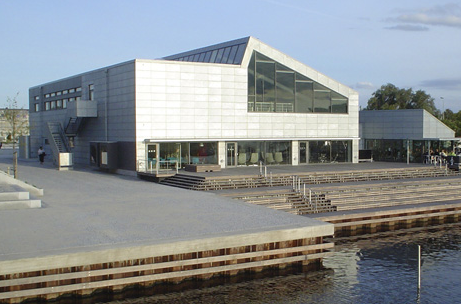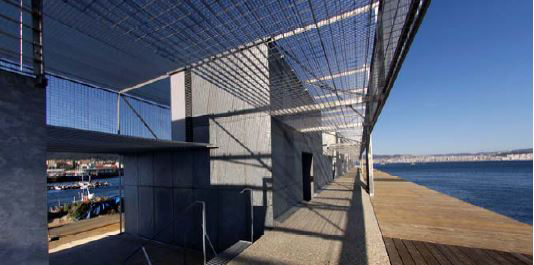Traditionally galvanizing is chosen because of the durable corrosion protection, but now we see more and more applications where architects choose galvanizing for aesthetic reasons. The crude metal surface creates very attractive contrasts with, for example, wood or glass.
The increasing interest in environmental issues that currently exist in the community, also speaks for hot-dip galvanizing for corrosion protection. Galvanized the steel obtained greatly increased lifespans, saving raw materials and energy. The fact that galvanized steel seldom or never needs maintenance also contributes to an environment friendly profile.
Cases
The Silo, Copenhagen

Photo credit: Rasmus Hjortshøj – COAST
“In the new district Nordhamnen in Copenhagen, Denmark’s most expensive apartment is built in an old silo. The 380 square meter apartment with four balconies is now announced for DKK 30 million”
This was to be read in a Swedish newspaper recently. For the Copenhageners, the worn concrete silo with the graffiti text ”Hva drikker mølr” was a well-known profile, but hardly any beautiful building. Therefore, the change is even more impressive! The 42 apartments in the renovation project “The Silo” in Nordhamnen are ready for occupation in December and are now out for sale. The old building has undergone a wonderful transformation, and we at Nordic Galvanizers are of course proud that Architect Cobe, who designed the conversion, chose hot-dip galvanized steel to the facade of this prestigious building!
The building is located near the sea and the corrosion category is considered to be C4. The coating thickness was specified to a minimum of 100 microns. The used steel was S 235 with a slicium content in the area 0.20-0.25 % and a thickness of 3 mm. The facade consists of a large number of pieces, many with their own identity, and the traceability during the assembling process has been of large importance.
Stockholmsmässan International Fairs, Sweden

The Stockholmsmässan International Fairs in Älvsjö is one of the world’s leading organizers of meetings with 10,000 exhibitors and 1.5 million visitors annually. Alessandro Ripellino/Rosenbergs Architects’ latest addition to the premises is a new multifunctional space intended for conferences and large exhibitions – the AE-hall.
The whole building is wrapped in a facade screen comprising approximately 1500 semi-perforated galvanized steel panels. They form a giant metallic basket with an embossed effect which is intensified by lighting fixtures that are integrated in the galvanized steel structure.
The hall is connected to the existing complex by a gallery which has also been remediated, with new mirror-like ceilings and greenery walls. Galvanizer: Häfla Bruk AB.
Lomma Library, Sweden

Henrik Jais-Nielsen Mats White Arkitekter AB has created a building, between the existing center and a new district by the sea, with a key position in the cityscape. The library building is simple in form, fully clothed with hot dip galvanized steel sheets it differs from all of its immediate surroundings, but associate with the port environment with boats and shacks. The building is located on an elevated granite plateau with an entrance ramp across its width. Heating coils with glycol enters the zone of snow and ice-free – good for parquet floors in the library. Far ahead towards the water and the view is a smaller detached café building, an architectural “little brother” to the library, from where it can also be accessed. Galvanizer: JIWE Varmförzinkning AB.
Quarter “De Gamles Vänner” Enskede, Stockholm, Sweden

The project consists of four houses along Gamla Tyresövägen in Enskede in south part of Stockholm. The houses are turning their short side to the street to provide as much contact as possible with the forest slope above. The facades are performed with 3 mm galvanized steel plates. Architect: Joliarc.
Fishermen wharf warehouses in Cangas’ Harbour, Pontevedra, Spain

A building made of galvanized steel, evoking shipbuildings, providing the necessary flexibility during its constrution and maximum reuse of the material its build of. Rectangular hollow shape structure defines the volumes and modulates closing sheet metal to support them. Lattices in different degrees of density provides unity to the building. The sheets of front (2000x1000x10 mm) were prepared by welded L profiles, so that they could be hung on the omega shapes fixed to the structure and in order to avoid possible deformations in the process of hot-dip galvanizing. The cover is formed also by sheets on U profiles that allow the water evacuation by means of small gargoyles. Lattice panels formed by electro-weld grids (30×10 and 40×10) have been used, depending on the savedlight, with changeable of 60 and 102 (measures of standard manufacture) in order to obtain diverse graduations of transparency to the set.
Karlstad Brigade Museum, Sweden

The 3 mm steel plates were cut in diamond shape and then hot-dip galvanized. The plates were mounted to the wall by overlap screwing at the top. The buildings were finished in August 2012. Steel work: Weland Stål AB. Galvanizer: Zinken Weland Ulricehamn AB.
IKEA store in Copenhagen, Denmark

The plates in this facade was galvanized 1992-1993. The original coating size was 80-85 microns. Today it is about 70 microns left. The building is located close to the motorway to Helsingör.
JYSK store in Roslilde, Denmark

The plates in this building, JYSK store in Roskilde, are galvanized by DOT, Dansk Overflade Teknik A/S.
New Technical School in Roskilde, Denmark

Ringsted Pool, Denmark

Galvanizer: Nordvestjysk Galvanisering A/S.
